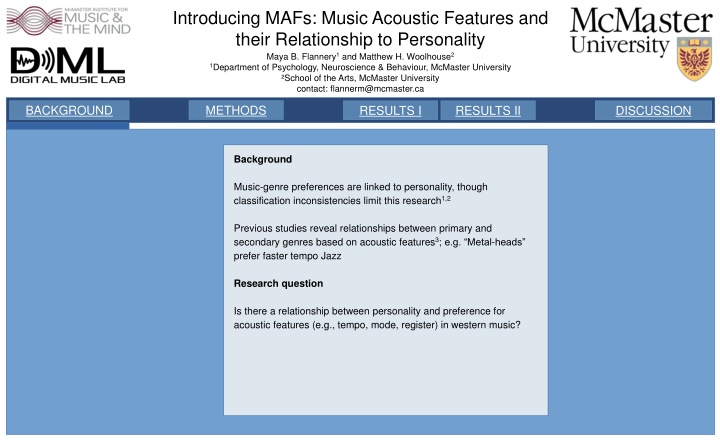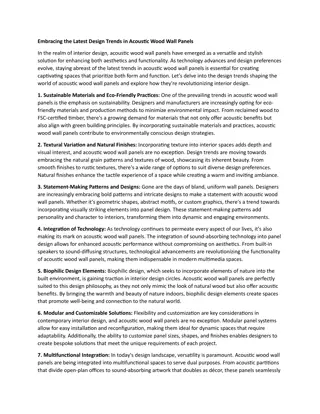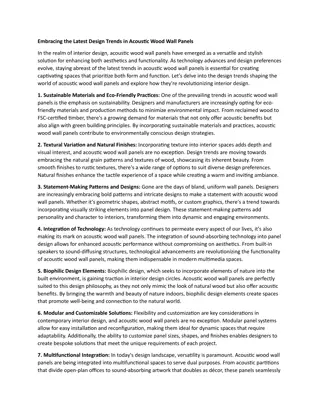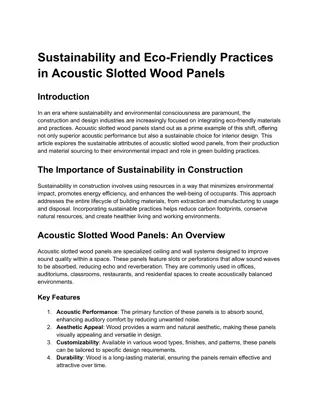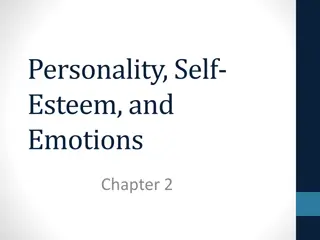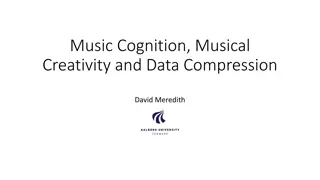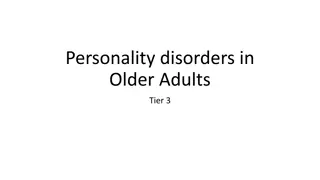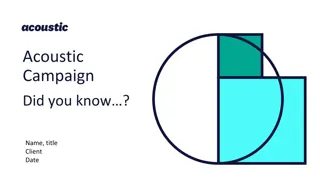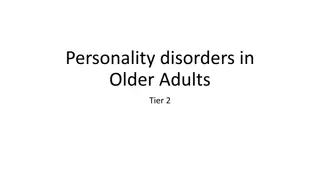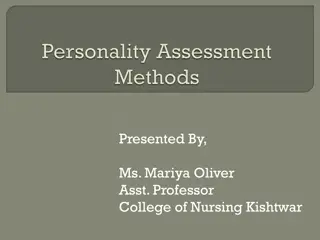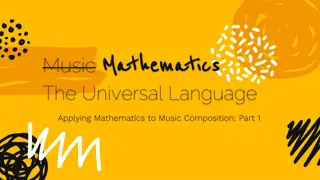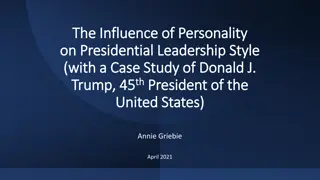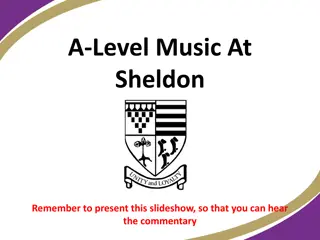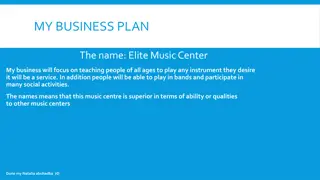Investigating Relationship Between Personality and Music Acoustic Features
This research by Maya B. Flannery and Matthew H. Woolhouse explores the connection between personality and music genre preferences based on acoustic features in Western music. The study involved undergraduate students and analyzed factors like tempo, mode, register, and their impact on individual preferences. Significant findings include main effects on preference ratings based on dynamic, mode, piece, and tempo, with interesting insights on the influence of personality factors like Agreeableness.
Download Presentation

Please find below an Image/Link to download the presentation.
The content on the website is provided AS IS for your information and personal use only. It may not be sold, licensed, or shared on other websites without obtaining consent from the author.If you encounter any issues during the download, it is possible that the publisher has removed the file from their server.
You are allowed to download the files provided on this website for personal or commercial use, subject to the condition that they are used lawfully. All files are the property of their respective owners.
The content on the website is provided AS IS for your information and personal use only. It may not be sold, licensed, or shared on other websites without obtaining consent from the author.
E N D
Presentation Transcript
Introducing MAFs: Music Acoustic Features and their Relationship to Personality Maya B. Flannery1 and Matthew H. Woolhouse2 1Department of Psychology, Neuroscience & Behaviour, McMaster University School of the Arts, McMaster University contact: flannerm@mcmaster.ca METHODS BACKGROUND RESULTS I RESULTS II DISCUSSION Background Music-genre preferences are linked to personality, though classification inconsistencies limit this research1,2 Previous studies reveal relationships between primary and secondary genres based on acoustic features3; e.g. Metal-heads prefer faster tempo Jazz Research question Is there a relationship between personality and preference for acoustic features (e.g., tempo, mode, register) in western music?
Introducing MAFs: Music Acoustic Features and their Relationship to Personality Maya B. Flannery1 and Matthew H. Woolhouse2 1Department of Psychology, Neuroscience & Behaviour, McMaster University School of the Arts, McMaster University contact: flannerm@mcmaster.ca METHODS BACKGROUND RESULTS I RESULTS II DISCUSSION Participants Stimuli (Within-Subjects IV) Undergraduate students (N = 90, 76 female) Ages ranged from 17 21 (M = 18.5, SD = 0.68) Musical training ranged from no training (n = 26) to more than 10 years (n = 15) [M = 4.1] Dynamic: Forte/Piano Stimulus intensity was normalized Spectral and amplitude envelopes differed; produce soft versus hard playing Mode: Major/Minor Original work in Major key Transposed to parallel minor Personality Measure (Between-Subjects IV) Piece: Three 16-second piano excerpts from Bach, Prelude in C# Major, BWV 848 Mozart, Piano Sonata in D Major, K311 Beethoven, Sonata in A Major, No. 2, Op. 2 Stimulus example Example of Mozart stimulus with piano dynamic, major mode, low register, and fast tempo Big Five Inventory: 44-item questionnaire determining an individual s position along five personality factors: Extraversion, Agreeableness, Conscientiousness, Neuroticism, Openness Analysis Register: High/Low Transposition carried out with respect to original register One octave higher; one octave lower Personality factors were arranged into High and Low levels (above or below the median for that factor) Preference (Dependent Variable) Separate mixed factorial ANOVAs were performed for each personality factor Personality factors were between-subject variables Music acoustic features were within-subject factors Participants were treated as random-effects Tempo: Fast/Slow; Adjusted for each piece to equal 16 seconds in duration Rate preference from Dislike (0) to Like (100) for each stimulus Factor combinations resulted in 48 stimuli
Introducing MAFs: Music Acoustic Features and their Relationship to Personality Maya B. Flannery1 and Matthew H. Woolhouse2 1Department of Psychology, Neuroscience & Behaviour, McMaster University School of the Arts, McMaster University contact: flannerm@mcmaster.ca METHODS BACKGROUND RESULTS I RESULTS II DISCUSSION Main Effects: MAFs There were significant main effects for four of the five MAFs on preference ratings: Dynamic, F(1, 4218) = 50.001, p < .001, 2 Mode, F(1, 4218) = 34.238, p < .001, 2 Piece, F(2, 4218) = 61.488, p < .001, 2 and Mozart Tempo, F(1, 4218) = 110.156, p < .001, 2 Register did not have a significant main effect p = .012: piano was preferred over forte p = .008: major was preferred over minor p = .028: Bach was preferred over both Beethoven Main Effects: Personality Factors Agreeableness, F(1, 88) = 5.13, p < .026, 2 of Agreeableness rated stimuli higher overall p = .001: participants with high levels p = .025: fast was preferred over slow
Introducing MAFs: Music Acoustic Features and their Relationship to Personality Maya B. Flannery1 and Matthew H. Woolhouse2 1Department of Psychology, Neuroscience & Behaviour, McMaster University School of the Arts, McMaster University contact: flannerm@mcmaster.ca METHODS BACKGROUND RESULTS I RESULTS II DISCUSSION Interactions: Personality and MAFs Each personality factor interacted with at least two MAFs Agreeableness with Piece and Tempo Conscientiousness with Mode, Piece, and Tempo Extraversion with Dynamic, Mode, Register, and Tempo Neuroticism with Tempo and Register Openness with Dynamic and Piece
Introducing MAFs: Music Acoustic Features and their Relationship to Personality Maya B. Flannery1 and Matthew H. Woolhouse2 1Department of Psychology, Neuroscience & Behaviour, McMaster University School of the Arts, McMaster University contact: flannerm@mcmaster.ca METHODS BACKGROUND RESULTS I RESULTS II DISCUSSION References 1. Aucouturier, J.-J., & Pachet, F. (2003). Representing Musical Genre: A State of the Art. Journal of New Music Research, 32(1), 83 93. 2. Greenberg, D. M., Kosinski, M., Stillwell, D. J., Monteiro, B. L., Levitin, D. J., & Rentfrow, P. J. (2016). The Song Is You: Preferences for Musical Attribute Dimensions Reflect Personality. Social Psychological and Personality Science, 7(6), 597 605. 3. Barone, M. D., Bansal, J., & Woolhouse, M. H. (2017). Acoustic Features Influence Musical Choices Across Multiple Genres. Frontiers in Psychology, 8, 931. 4. Bansal, J., Flannery, M. B., & Woolhouse, M. H. (2020). Influence of personality on music-genre exclusivity. Psychology of Music. Discussion Results of this study support the link between personality and music preference. Piano dynamic, major mode, and fast tempo had higher preference ratings independent of personality factors. These features, especially major mode and fast tempo, are common in popular music. Future studies should investigate these relationship in more detail. Participants high in Agreeableness had higher preferences for music independent of MAFs. This result is in agreement with Bansal et al. (2020)4, which found listeners with high levels of Agreeableness were genre-inclusive they had a wide range of musical taste. Interactions between personality factors and MAFs can be linked to genre, music-preferences dimensions, and psychological attributes of music. For example, high extraversion is related to preference for major-mode, and in Greenberg et al. (2016)3, it is related to high arousal music major- mode music and arousal may be linked as well a topic for future research. There were clear preferences for Bach excerpts over Beethoven and Mozart; future studies should investigate a larger variety of musical features, such as melody, harmony, and timbre, which may explain this variation. Ethics Approved by McMaster Research and Ethics Board: #2524. Funding SSHRC Insight Development Grant (#430 2012 0835) and McMaster Arts Research Board. Acknowledgments Thank you Joanna Spyra, Wendy Tang, Madeline Komer for your support.
